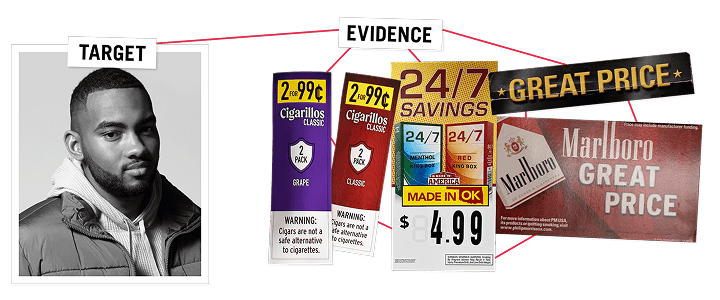
tobacco targets
Low-Income Communities
Built To Be Addictive. Priced To Be Accessible.
Ever noticed how some tobacco products seem cheaper in certain neighborhoods? That’s not an accident. Discounts. Freebies. Targeted ads. These aren’t random. They’re part of a long-term plan to keep people addicted.
In 2015, the tobacco industry spent more than $7 billion on discounting or lowering the cost of cigarettes.¹ These price drops weren’t about generosity; they were a business strategy.

A History of Predatory Marketing
This targeting isn’t new. Over the last 60 years, tobacco companies have:
- Handed out free cigarettes in low-income housing areas
- Offered coupons and discounts tied to government benefits
- Flooded communities with billboard ads and corner store displays
- Even when laws changed, the marketing didn’t stop — it just evolved
Store Locations Tell the Story
There are an estimated 375,000 tobacco retailers in the U.S. They’re disproportionately located in low-income communities, often near schools, exposing kids and teens to constant tobacco marketing.²
In Oklahoma alone, tobacco companies spend nearly $149 million a year on marketing. That money goes into the same neighborhoods already facing higher rates of illness, unemployment and limited access to health care.³
The impact is clear:
- More than a quarter of Americans living below the poverty line smoke, due to marketing tactics in their neighborhoods.⁴
- Blue-collar workers are more likely to smoke and suffer tobacco-related health consequences — many of which can be attributed to secondhand smoke from coworkers and smoke-friendly work environments.
- Although Americans living below the poverty line attempt to quit smoking at the same rate as others, they are less successful at quitting due to a lack of resources.
Tobacco Industry Influence in Oklahoma
| Annual tobacco industry marketing expenditures nationwide | $8.6 billion |
| Estimated portion spent for Oklahoma marketing each year | $148.9 million |
Source: Campaign for Tobacco-Free Kids
The Real Cost of “Cheap” Tobacco
Tobacco use leads to higher rates of:
- Lung and heart disease
- Cancer
- Missed workdays
- Out-of-pocket health costs
- Shorter life expectancy
Big Tobacco isn’t just selling a product. They’re selling a system that profits from inequality.